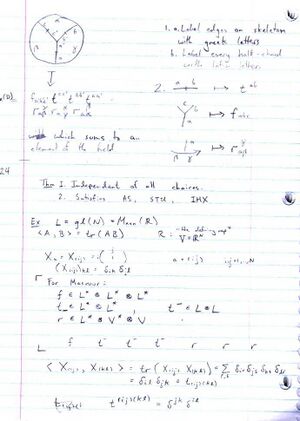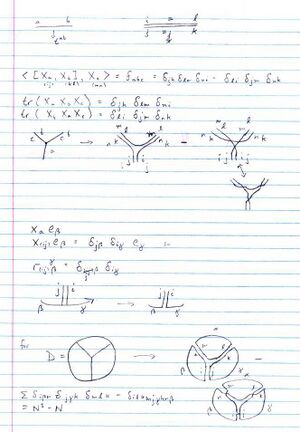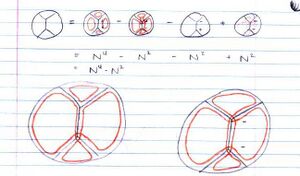06-1350/Class Notes for Tuesday October 24
| ||||||||||||||||||||||||||||||||||||||||||||||||||||||
What Cyclic Permutations Can't See
Believe or not, but the following questions are directly related to class material - specifically, to the determination of "The Envelope of The Alexander Polynomial".
Let denote the permutation group on letters and let denote its group ring. Let be the linear functional defined via its definition on generators by if the permutation is cyclic, and otherwise. Turn into a (symmetric!) bilinear form (also called ) on by setting .
Question 1. Determine the kernel of the bilinear form . (Recall that the kernel of a bilinear form is .
Question 2. For , I know by a lengthy computation (see below) that is in , where
(here denotes the transposition of and , denotes the permutation for which , and the bracket is taken in the additive sense: ). Do you have quicker explanation?
Question 3. By another lengthy computation for , I also know that , where
Do you have quicker explanation?
Question 4. I suspect that in some sense, though I'm not sure in which, and generate the whole kernel or at least some easily definable special part of the kernel of for all . Can you make sense of that?
The Lengthy Computations
The lengthy computation for (and likewise for ) involves multiplying 24 "test permutations" against a linear combination of 8 permutations and counting cycles in the resulting 192 permutations. Here's a Mathematica session that does that:
In[1]:=
|
S[n_] := (P @@@ Permutations[Range[n]]);
c[p_P] := If[
Length[p] == Length[NestWhileList[p[[#]] &, p[[1]], # > 1 &]],
1, 0
];
c[x_] := x /. p_P :> c[p];
Unprotect[NonCommutativeMultiply];
p1_P ** p2_P := p1 /. Thread[Rule[Range[Length[p2]], List @@ p2]];
p1_ ** (p2_ + p3_) := p1 ** p2 + p1 ** p3;
(p1_ + p2_) ** p3_ := p1 ** p3 + p2 ** p3;
p1_ ** (c_*p2_P) := c p1 ** p2;
(c_*p1_P) ** p2_ := c p1 ** p2;
b[a_, b_] := a ** b - b ** a;
|
In[2]:=
|
H = b[P[2, 1, 3, 4], b[P[3, 2, 1, 4], P[4, 2, 3, 1]]]
- P[1, 3, 2, 4] + P[1, 4, 3, 2] + P[3, 2, 1, 4] - P[4, 2, 3, 1]
|
Out[2]=
|
-P[1, 3, 2, 4] + P[1, 4, 3, 2] + P[2, 3, 4, 1] - P[2, 4, 1, 3] -
P[3, 1, 4, 2] + P[3, 2, 1, 4] + P[4, 1, 2, 3] - P[4, 2, 3, 1]
|
In[3]:=
|
c[# ** H] & /@ S[4]
|
Out[3]=
|
{0, 0, 0, 0, 0, 0, 0, 0, 0, 0, 0, 0, 0, 0, 0, 0, 0, 0, 0, 0, 0, 0, 0, 0}
|
In[4]:=
|
Y4 = b[P[2, 1, 3, 4], P[1, 3, 2, 4]] - b[P[1, 3, 2, 4], P[1, 2, 4, 3]] +
b[P[1, 2, 4, 3], P[4, 2, 3, 1]] - b[P[4, 2, 3, 1], P[2, 1, 3, 4]]
|
Out[4]=
|
P[1, 3, 4, 2] - P[1, 4, 2, 3] - P[2, 3, 1, 4] + P[2, 4, 3, 1] +
P[3, 1, 2, 4] - P[3, 2, 4, 1] - P[4, 1, 3, 2] + P[4, 2, 1, 3]
|
In[5]:=
|
c[# ** Y4] & /@ S[4]
|
Out[5]=
|
{0, 0, 0, 0, 0, 0, 0, 0, 0, 0, 0, 0, 0, 0, 0, 0, 0, 0, 0, 0, 0, 0, 0, 0}
|


















![{\displaystyle H=[(12),[(13),(14)]]-(14)-(23)+(13)+(24)}](https://wikimedia.org/api/rest_v1/media/math/render/svg/8f69d8796c7a6869db0e02e3507ffd108aff26a6)
![{\displaystyle \ \ =[2134,[3214,4231]]-4231-1324+3214+1432}](https://wikimedia.org/api/rest_v1/media/math/render/svg/c4636708ab7bc762af5b954d64d561249b5211ba)






![{\displaystyle [\tau ,\sigma ]:=\tau \sigma -\sigma \tau }](https://wikimedia.org/api/rest_v1/media/math/render/svg/7329b2eb28a6fc76f28fedb2f2eae8871ceef03c)


![{\displaystyle 4Y=[(12),(23)]-[(23),(34)]+[(34),(41)]-[(41),(12)]}](https://wikimedia.org/api/rest_v1/media/math/render/svg/a7e9e645e405226f25ee8c119c8169745f4eae2b)




